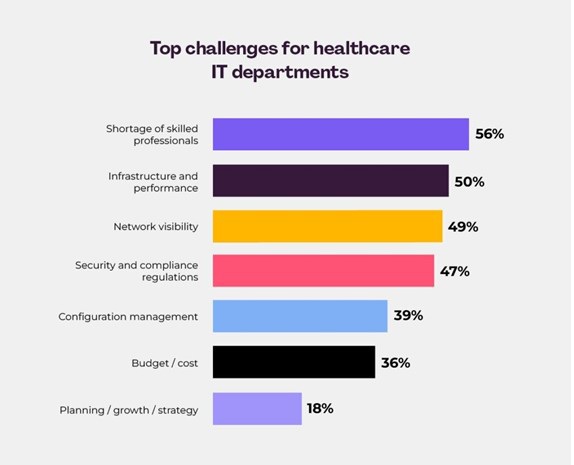
Information technology serves as the digital backbone for doctors, nurses, and technicians to deliver quality patient care by sharing data and applications over secure IT networks. To help understand the top IT trends that are impacting the healthcare industry today, Auvik recently released a companion analysis for its 2024 IT Trends Report which analyzed survey responses from 2,000 IT professionals from North America and the UK, and compared results from professionals working in the healthcare industry to the larger sample. The report found that IT teams face multiple technical obstacles in their support for healthcare organizations.
Surprisingly, just 38% of IT professionals tracked end-user satisfaction as their top measure of success this year, down from 45% in 2023. Yet healthcare IT professionals spent more time responding to end-user requests compared to their IT peers in other industries. Almost three-fourths of healthcare IT pros (72%) spent 10 to 20 hours per week on these tasks, compared to less than two-thirds of overall IT professionals (64%).
Due to the increase in remote and hybrid work since the pandemic, less than 10% of internal IT teams said they still support a fully onsite workforce. But due to the human-touch aspects of the medical profession, healthcare IT professionals reported that 16% of their organizations still maintain completely onsite work environments. As a result, healthcare IT teams are more likely to maintain on-premises infrastructure.
Gaining Greater SaaS Visibility into the Network
Another surprising finding from the survey is the frequency with which healthcare IT teams back up network configurations compared to IT teams in other industries. Only 18% of healthcare IT respondents said they back up their networks daily, versus 27% across other sectors. Failing to perform backups regularly could lead to problems with data quality and network performance, and with resuming normal operations in the wake of a security incident or other network outage.
To be fair, 73% of healthcare IT environments still depend on aging legacy operating systems, according to data from HIMSS.org, and many of those networks host complex medical devices that require specialized management. In addition, implementing daily backups in healthcare can be logistically challenging due to the need for careful scheduling to avoid disruptions in patient care.
Another challenge involves the need for visibility into all cloud-based SaaS applications that run on the network, because IT professionals can't protect what they can't see. More than one-fourth of healthcare IT professionals reported having zero visibility into employees who shared accounts for SaaS applications (27%), which raises concerns about data security, privacy, and HIPAA regulatory compliance.
Unfortunately, it is a common practice in the healthcare industry for multiple employees such as nurses or admins to share a single security login for shared workstations. This practice introduces risks for unauthorized access and data breaches, particularly when employees fail to log out before leaving a workstation. It also allows former employees to maintain access to sensitive patient data after they have been offboarded.
To strengthen network visibility and security, IT teams can implement SaaS monitoring tools to automatically track accounts and activities across the entire organization. Another step involves hardening access controls to ensure that only authorized people are able to log into sensitive systems.
Closing the Talent Gap for Healthcare IT
Cost and budgetary constraints are always a concern for any IT team, however according to this year's finding, budget ranks as only the sixth biggest challenge for healthcare IT professionals. The top challenge for more than half of respondents involved a shortage of skilled IT professionals in the workforce (56%). That skills gap was followed closely by challenges involving network infrastructure and performance (50%); network visibility (49%); security and compliance (47%); and configuration management (39%).

In the healthcare field, IT networks are typically made up of multiple layers of interconnected webs, as most hospitals and clinics run separate networks for patient care, surgery centers, pharmacies, and labs. Other external IT functions may include support for insurance and billing, visitor Wi-Fi hubs, or applications for visiting physicians and therapists.
Of course, network security remains a central concern for healthcare IT teams. Over the coming year, healthcare IT professionals cited data loss prevention tools (51%), access-to-control tools (48%), and anomaly detection tools (47%) as their top choices to improve network security. Such tools highlight the importance of safeguarding patient data by monitoring network activity for unusual behavior, and managing user access to critical systems.
From meeting data privacy regulations to coordinating complex medical treatments, healthcare professionals must continuously navigate new challenges and technologies to deliver effective patient care, and IT has become central to that mission. Healthcare IT is an evolving field that requires constant foresight and planning to develop a clear technology strategy. That's why it is critical to periodically take the pulse of IT practitioners in the field to understand their most pressing concerns, and to consider strategies and solutions that can be implemented to improve patient care and enhance network security.
